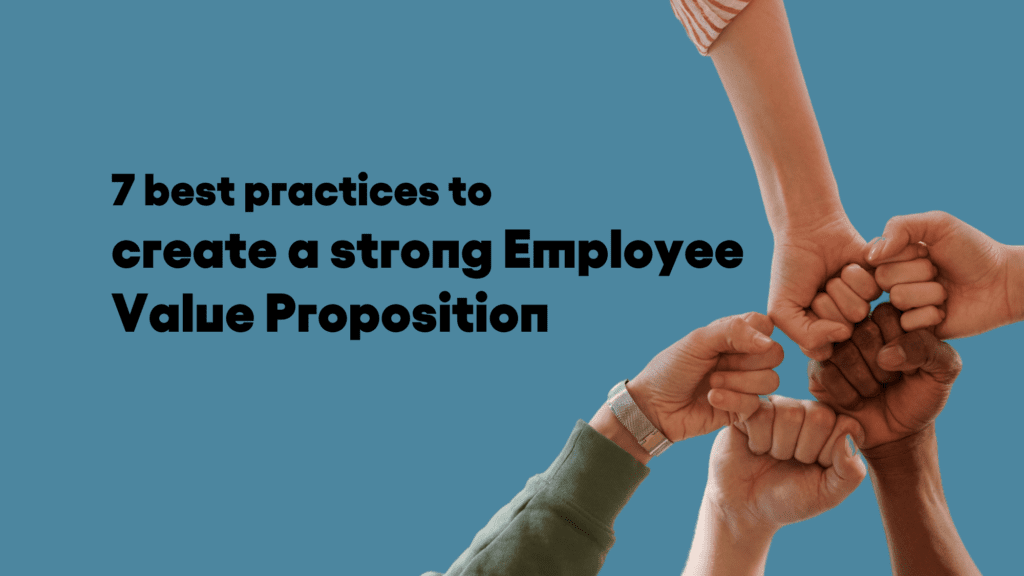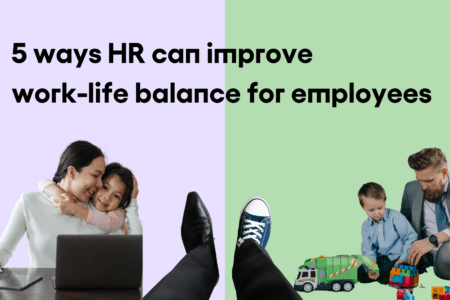It’s no secret that today’s job market no longer belongs to the employer and instead heavily prioritizes the employee experience above anything else.
Over the last 2 years, organizations have been exposed to what their employees need and value the most. And the reality check? Employees are no longer afraid to ask for what they want and aim to be part of organizations that mirror their own principles and that they feel proud to work for.
Every organization wants to hire top talent. And while it may not be too obvious at first, some organizations don’t have the right set of values, offerings, or don’t keep their promises to be able to retain top talent for the long-term, let alone hire them in the first place.
Whether your organization’s EVP needs a few updates to support today’s desired employee experience or needs a complete re-evaluation to be a job-hunter’s dream workplace, these 7 tips will surely make a difference in building a successful employee value proposition framework.
Look through the eyes of your ideal applicant
While obvious, many people could overlook or oversimplify this tip.
Thinking and working backwards to create a strong employee value proposition is one of the best ways you can accomplish this competitive challenge.
There are hundreds of candidates out there who are looking for a job, and it’s likely a handful of those are a great match for exactly what you’re looking for. However, the problem could be that you aren’t advertising the organization or writing a job description in a way that truly reflects what you want and what you offer. To be able to attract your right kind of talent means thinking like your ideal applicant, more specifically, one that will stay for the long-term. This involves looking at your offer from different angles and adopting their point-of-view.
“If we want a candidate to have over 5 years of experience, what’s the average salary for that role, and how can we stand out from the crowd?”
“If our top priority is to have a candidate that’s customer service-oriented and is great with people, how much do we really need to have a bachelor’s degree as a requirement?”
Rather than relying on a checklist of accomplishments that look bold on a resume, like degrees and awards, it’s important to first concretize the skills and competencies your dream candidate possesses, and how your organization could benefit from those. As an HR professional or hiring manager, this could help you put things into perspective and not only help you create job descriptions that call to your ideal future employees, but also create an EVP framework that is attractive to job seekers, as it shows you are an employer that determines candidate fit by prioritizing skills, and not just diplomas.
Make few pledges, keep all promises
A trustworthy employer will attract loyal employees.
If your organization is in the process of coming up with an effective employee value proposition framework, it can be tempting to jump in headfirst and make all kinds of attractive promises that make the company look like everyone’s dream job.
However, there is always the very unpleasant possibility that these promises might not work for your organization, and holding your end of the deal can be a challenge. That means letting down talented employees and losing them, ultimately damaging your employer brand.
Company goals and values should always reflect the reality of the workplace. When creating a strong employee value proposition, it’s not only important to come up with a solid employer brand strategy to look good for potential applicants and candidates but to consider how the promises you make to your employees can impact the delivery of your product or service to your clients.
For instance, if you make the decision to transition to a 4-day workweek, but business starts booming on the one day where staff does not want to be available or can only operate at 50%, then this employer promise isn’t the best fit for your organization. While making this decision, you may have considered how you want to improve work-life balance for employees, but some industries simply cannot function with this sort of arrangement. Fortunately, there are plenty of other ways to make sure employees are leading full lives outside the (virtual) office, and there are always exciting perks and things to look forward to for lots of employees that don’t come in the form of less time at work
Show off your impact
Employees are more excited to get to work if they know every effort makes a positive change in the world. As a result, you’ll have employee productivity at all-systems go, creating a sense of fulfillment in the process within your team. As an organization, how you make a positive impact should be a large part of your employee value proposition framework.
In a study done by Cone Communications, 94% of Generation Z (the rapidly growing future of the workforce) believe all companies should address critical social issues, while 60% of Gen-Z job applicants name a company’s missions and values as one of the main reasons for applying for a particular role.
A company needs to make a positive impact for most of the future workforce to even consider them as an employer, proving once again just how much this has become an employee’s market. The employer brand strategy needs to place a good amount of emphasis on what the organization does that lends a helping hand, and what it does to contribute to bettering society.
Spend to save
It’s true, while good money isn’t the only perk an organization can offer, it’s an important one, as it is an impactful component of an employee’s quality of life. Even though an organization has a strong employee value proposition, if the salary they offer a candidate does not match their skillset or level of expertise, employees will be more likely to start pursuing other job or career opportunities.
In many cases, an employee’s departure can end up costing an organization more than double the annual salary of said employee. Aside from that, underpaying employees or offering salaries that don’t reflect what they do creates a turnover rate that can land your organization negative online reviews drawing a poor image of your employer brand.
Investing in your employees is one of the profitable things you can do for your organization. Many studies have confirmed that giving employees competitive salaries increases productivity, improves business, increases profit, and attracts top talent.
Great company culture and positive global impact are important components of what an organization should be made of. But it’s important to remember that happy employees are what make all these things happen in the first place. That’s why it’s imperative to show that your employees are appreciated by being appropriately compensated for their efforts.
Proudly promote career growth
When a new employee begins their journey with you, they often imagine two very different possible plans of action for the future: move up or move on.
To avoid the latter, especially when it comes to top performers, contributing to your employees’ career development is an effective way of keeping them happy and eager to stay with the organization. This can be carried out in different forms, like paying for courses or certifications, regularly coaching, hiring internally, and even creating new positions that encompass what the employee can do to improve organizational performance.
While some employers may fear that this could result in the employee leaving for a different organization equipped with new skills, it can also result in the opposite. A 2019 study found that “94% of employees say that they would stay at a company longer if it simply invested in helping them learn”. This was especially the case in young workers.
A strong employee value proposition will always prioritize employee growth. This shows that employers are aware that attractive opportunities exist outside their office and accept that employees will do what’s best for them. By promoting their personal growth, this shows employees that they can find great career success in the organization they are already with.
Place effort on the candidate experience
It might seem like if an individual isn’t hired, it doesn’t matter what they think about your organization. However, caring about the first impression you make on candidates can go a long way. For example, a study showed that a whopping 75% of candidates never received notice of a final decision after interviewing for a role! This promotes a negative candidate experience, and, with the power of easy communication on the internet, can quickly have a detrimental effect on your organization’s employer branding.
Combatting this type of negative impact can simply mean treating candidates professionally and with respect, like having an answer for them, promptly responding to their questions, and genuinely caring about their concerns. To understand how your organization can do better, candidate experience surveys are a great tool to be able to understand what is attractive to applicants, and what can make the interview experience a better one for future job seekers.
Know your culture
Ever wondered how to measure company culture?
To present an accurate and strong employee value proposition means knowing exactly what you will be offering to future employees. Investing time into becoming self-aware as an organization means knowing what strengths are present, what strengths you’d like to welcome, and what areas of development need to be worked on.
With a tool like SuccessFinder’s Culture Fit, you can identify the key behaviors that best align with your company’s unique culture. By doing so, you can increase revenue, boost employee satisfaction, and reduce turnover rates.
To predict culture fit as well as culture add, SuccessFinder starts by decoding your own culture first by not only looking at current behaviors but aspirational value-based behaviors that you’d like to have as a part of your company culture. Next, using the acquired data, we create a cultural benchmark that pinpoints behaviors specific to your organizational culture. Each time you hire, you can cross-reference this benchmark.
With these science-backed insights, you can quickly see how candidates compare to your benchmark and identify the unique contributions and potential challenges.
Psychometric testing in recruitment is the key to success for your organization.
Book a demo with us today and see why hundreds of organizations love us.




